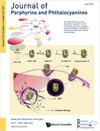用[双(邻甲基吡啶)(二甲基酯原卟啉)Fe(III)]氯化物研究轴向配体对箍缩卟啉过氧化物酶活性的影响
IF 0.9
4区 化学
Q4 CHEMISTRY, MULTIDISCIPLINARY
引用次数: 0
摘要
合成并表征了一种新的六配位化合物,该化合物是氯二甲基酯原卟啉-Fe(III)1和2-甲基铱(2–CH3Py)反应的产物。[双(邻甲基吡啶)(二甲基酯原卟啉)Fe(III)]氯化物2是一种箍缩卟啉家族的化合物,是过氧化物酶的模型。我们使用UV-Vis、1H NMR和EPR光谱以及其过氧化物酶活性的动力学定量和计算分析来分析2,以评估在一系列箍缩铁原卟啉配合物中与1配位的箍缩配体的存在,如先前报道的那样。我们的研究表明,当异烃基链连接到轴向配位为1的吡啶基上时,分别由过氧化物酶活性测定1和2衍生的化合物I的氧化剂活性得到更好的控制;在由箍缩卟啉与picdien轴向配体和过氧化氢进行的反应过程中,与化合物0形成相关的活化能值降低证明了这种效应。当将基于铁(III)的配合物的量子混合自旋态(qms)中的[公式:见文本]3/2、[公式:看文本]5/2的贡献与其过氧化物酶活性相关联时,我们发现当铁(III。当[式:见正文]甲基吡啶用作轴向配体时,由于与其配位数相关的铁几何结构的扭曲,这可能是影响过氧化物酶活性的一个基本特征。本文章由计算机程序翻译,如有差异,请以英文原文为准。
Investigating axial ligand impact on pinch-porphyrin peroxidase activity with [bis(o-methylpyridino) (dimethylesterprotoporphyrinato)Fe(III)] chloride
The synthesis and characterization of a novel hexacoordinated compound as a product of the reaction between chlorodimethylesterprotoprphyrin–Fe(III) 1 and 2–methylpiridine (2–CH3Py) was performed. The [bis(o–methylpyridino)(dimethylesterprotoporphyrinato)Fe(III)] chloride 2 is a compound of the family of the pinch–porphyrins, a model of peroxidase enzymes. We analyzed 2 using UV-Vis, 1H NMR, and EPR spectroscopies, as well as kinetic quantifications of its peroxidase activity and computational analysis, to evaluate the presence of the pinch-ligand coordinated to 1 in a series of pinch-ironprotoporphyrin complexes, as previously reported. Our investigation revealed that the oxidant activity of Compound I derived from peroxidase activity determination of 1 and 2, respectively, is better controlled when a heterohydrocarbonated chain is attached to the pyridyl groups that coordinate axially to 1; an effect evidenced by a decrease of the activation energy value associated with Compound 0 formation during the reaction performed by pinch–porphyrin, with the picdien axial ligand and hydrogen peroxide. When correlating the contribution of [Formula: see text]3/2 in the quantum mixed-spin state (qms), [Formula: see text]3/2, [Formula: see text]5/2, of iron(III)-based complexes with their peroxidase activity, we found that when the qms [Formula: see text]3/2, [Formula: see text]5/2, of iron(III) had 80% character [Formula: see text]3/2, the peroxide activity increased significantly. This could be a fundamental trait that could affect the peroxidase activity owing to the distortion of the iron geometry associated with its coordination number when [Formula: see text]methylpyridine is used as an axial ligand.
求助全文
通过发布文献求助,成功后即可免费获取论文全文。
去求助
来源期刊
CiteScore
2.10
自引率
20.00%
发文量
62
审稿时长
1 months
期刊介绍:
The Journal of Porphyrins and Phthalocyanines (JPP) covers research in the chemistry, physics, biology and technology of porphyrins, phthalocyanines and related macrocycles. Research papers, review articles and short communications deal with the synthesis, spectroscopy, processing and applications of these compounds.

 求助内容:
求助内容: 应助结果提醒方式:
应助结果提醒方式:


